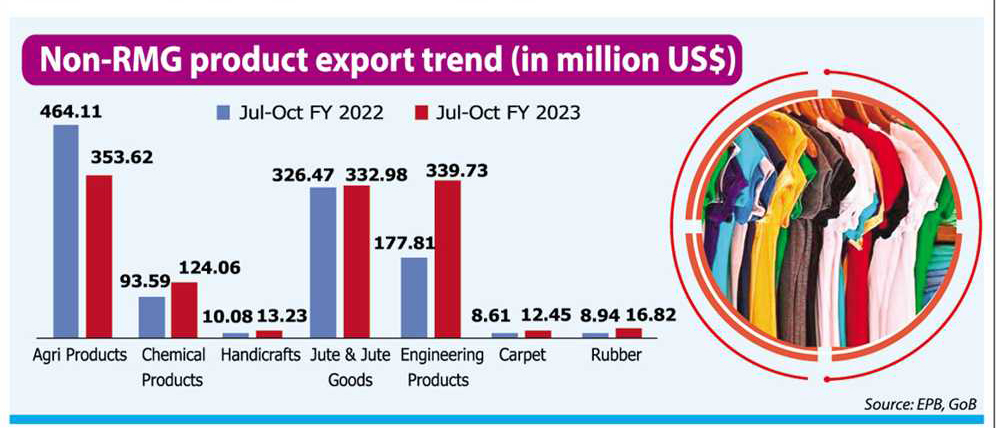Originally posted in THe Financial Express on 6 November 2022
Export diversification takes a knock
Bangladesh’s macro-economy is to bleed further as its once- impressive non-RMG exports were hit hard in recent months for the demand-side slump across the globe amid a virtual recession, analysts say.
An FE analysis has found that the economic impact of the downturn could be severe on the foreign- exchange earnings from the diversified export baskets.

Although the shipment of the ready-made garments (RMG) to the overseas market is still on the positive trajectory, the important non-RMG products’ earnings were falling in recent months, the analysis found.
According to Export Promotion Bureau (EPB) data, jute and jute goods, engineering products, agricultural products, frozen and live fishes, chemical products, handicrafts, rubber, carpet, specialized textiles, and glass and glass-ware have recorded a steep fall during the first four months of the current fiscal (FY)2022-23.
Most of the above-mentioned products, which are facilitating diversification of Bangladesh’s export basket, had been on a rising trajectory until a couple of months ago, the FE finds analysing the EPB data.
According to the EPB, the highest export-earning sector-RMG- maintained a 10.55-percent growth during July-October period of the current FY2023.
However, export earnings from the light-engineering products plunged 47 per cent during the first four months of the current FY2023 despite an impressive growth shown over the last couple of years.
The export of engineering products, a key facilitator to the country’s export diversification, dipped to only US$177.81
million during the Jul-October period of FY2022 compared to $339.73 million in the same period last FY2022, the EPB data showed.
Similarly, earnings from the shipment of agricultural products, another main driver to the export diversification, also plunged by 24 per cent to $353.62 million in the period of the current fiscal compared to $464.11 million in the same period last fiscal.
The earnings from the frozen- and live-fish shipments also dropped 24 per cent to $171.67 million in Jul-Oct period of the current fiscal from that of $225.23 million in the past fiscal.
The foreign-exchange earnings from the chemical products, which had maintained a rising trend a few months ago, also climbed down 25 per cent to $93.59 million.
During the July-Oct period, the export earnings from jute and jute goods had fallen by 2.0 per cent to $326.47 million, the official data showed.
The earnings from the handicraft, glassware, carpet, specialized textiles, and other manufactures like furniture, golf shaft, optical, photographic and medical instruments, also dipped in the recent months.
The FE analysis has found that the agricultural products, leather and leather products, and jute and jute goods, fetched over $1.0 billion worth of export earnings in the last fiscal while light- engineering products, frozen and live fishes, chemical products, glass and glass-ware, rubber, and carpet were also on an impressive trajectory.
Meanwhile, the foreign-exchange earnings from the shipments of plastic products, and leather and leather products maintained a growth along with the RMG products during the Jul-Oct period of the current FY2023, the FE analysis has found.
Centre for Policy Dialogue (CPD) Distinguished Fellow Prof Mustafizur Rahman told the FE that the demand- side fall and higher raw-material prices might have affected the promising non-RMG products.
“The sudden impact amid the global scenario, including Russia-Ukraine war and higher energy prices, had already swelled the inflation across the globe, resulting in a cut in demand for the products in the importing countries,” he adds.
However, if the government ensures trade facilitation and improves the doing- business environment at home, then the export in the future days will again rebound and will help in the diversification of the foreign-exchange earnings, Professor Rahman says.
Bangladesh in the last FY2022 earned $52.08 billion worth of foreign exchange from the export of its different products where nearly 82-percent contribution was from the apparel sector.



